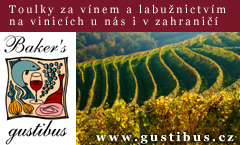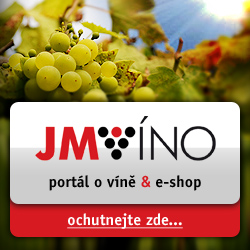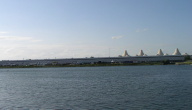 The largest drinks fair in the world takes place at the exhibition halls in Bordeaux-Lac every two years. This huge exhibition centre by the lake to the north of this famous wine city is over a mile in length, meaning you often need a 20 minute walk from one appointment to the next, although golf caddies can be found to whizz you up or down the entire length of Hall 2 if you are lucky. Here between 17 and 21 June, 2400 exhibitors arrived from 45 countries, mainly to show off their wares and find distributors or importers for their beverages, which include sparkling and fortified wines as well as spirits, and also to meet old friends and sample new products. The largest drinks fair in the world takes place at the exhibition halls in Bordeaux-Lac every two years. This huge exhibition centre by the lake to the north of this famous wine city is over a mile in length, meaning you often need a 20 minute walk from one appointment to the next, although golf caddies can be found to whizz you up or down the entire length of Hall 2 if you are lucky. Here between 17 and 21 June, 2400 exhibitors arrived from 45 countries, mainly to show off their wares and find distributors or importers for their beverages, which include sparkling and fortified wines as well as spirits, and also to meet old friends and sample new products.
According to the official catalogue the total sales for the wine and spirits industry in 2005 amounted 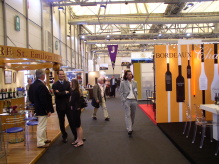 to US$ 277 billion, a figure that grows exponentially year by year. With this never out of mind a new "Marketers" section was introduced this year, featuring a series of seminars and lectures on global financial trends and dedicated to such themes as packaging and design, logistics, training and promotion. to US$ 277 billion, a figure that grows exponentially year by year. With this never out of mind a new "Marketers" section was introduced this year, featuring a series of seminars and lectures on global financial trends and dedicated to such themes as packaging and design, logistics, training and promotion.
The pre-opening bash at the casino by the lake was hosted by 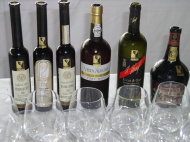 Les Citadelles du Vin, a wine contest organised in Côtes de Bourg, a lesser known Bordeaux appellation - see www.citadellesduvin.com, giving some excellent value wines but lying on the wrong side of the estuary from the grand châteaux of the Médoc. All the winning wines were on offer before and during the elaborate dinner. Included were three speciality wines from the Czech Republic, two ice wines from Znovín Znojmo and a straw wine from Vinné sklepy Valtice in miniscule bottles that did not last long. Les Citadelles du Vin, a wine contest organised in Côtes de Bourg, a lesser known Bordeaux appellation - see www.citadellesduvin.com, giving some excellent value wines but lying on the wrong side of the estuary from the grand châteaux of the Médoc. All the winning wines were on offer before and during the elaborate dinner. Included were three speciality wines from the Czech Republic, two ice wines from Znovín Znojmo and a straw wine from Vinné sklepy Valtice in miniscule bottles that did not last long.
While Bordeaux may style itself the world's wine capital, others begged to differ. A host of tutored tastings took place during the five days of the fair, with Austria, Italy and Germany working hardest, 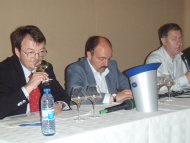 and a very instructive session with some of Burgundy's leading producers. As an introduction to a comparison of Rieslings from Germany, Austria and Australia (France's Alsace region was not even represented) UK wine journalist Robert Joseph and Gérard Basset, MW, offered the opinion from the podium that the most important grape varieties in the world are not the ubiquitous Chardonnay and Cabernet Sauvignon, but rather Riesling and Pinot Noir. The irony being that neither of these is cultivated in Bordeaux. and a very instructive session with some of Burgundy's leading producers. As an introduction to a comparison of Rieslings from Germany, Austria and Australia (France's Alsace region was not even represented) UK wine journalist Robert Joseph and Gérard Basset, MW, offered the opinion from the podium that the most important grape varieties in the world are not the ubiquitous Chardonnay and Cabernet Sauvignon, but rather Riesling and Pinot Noir. The irony being that neither of these is cultivated in Bordeaux.
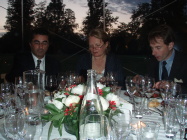 For those of the international press dinners at resplendent Bordeaux châteaux have been arranged, which are always the main highlights of the Vinexpo week, culminating with the Fête de la Fleur at Château Smith-Haut-Lafitte this year. For instance those under the wing of press attachée Michele Piron-Soulat, sister of winemaker Dominique (www.domaines-piron.fr), there was the traditional visit to Château de France (www.chateau-de-france.com), a medium-sized château in the AOC of Pessac-Léognan, a few kilometres south-west of Bordeaux. The vineyards here date back For those of the international press dinners at resplendent Bordeaux châteaux have been arranged, which are always the main highlights of the Vinexpo week, culminating with the Fête de la Fleur at Château Smith-Haut-Lafitte this year. For instance those under the wing of press attachée Michele Piron-Soulat, sister of winemaker Dominique (www.domaines-piron.fr), there was the traditional visit to Château de France (www.chateau-de-france.com), a medium-sized château in the AOC of Pessac-Léognan, a few kilometres south-west of Bordeaux. The vineyards here date back  to the 18th century, an important time in Bordeaux, as the notion of quality ranking of the grand cru type was beginning to take shape. The proprietors, Bernard Thomassin and his son Arnaud, who is production manager and in charge of marketing, welcomed us with free-flowing Champagne Paul Roger and a jazz band on the to the 18th century, an important time in Bordeaux, as the notion of quality ranking of the grand cru type was beginning to take shape. The proprietors, Bernard Thomassin and his son Arnaud, who is production manager and in charge of marketing, welcomed us with free-flowing Champagne Paul Roger and a jazz band on the 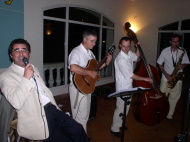 terrace. Production here is 200,000 bottles from 37 hectares of red varieties (Cabernet Sauvignon and Merlot) and 3 hectares of white Sauvignon Blanc and Sémillon grapes, all from the gravelly soil associated with the Graves area. The evening was graced by Jacques Orhon, French-born Canadian wine writer, broadcaster and TV personality who entertained the guests briefly with his rendition of songs such as Quelques gouttes de Champagne... terrace. Production here is 200,000 bottles from 37 hectares of red varieties (Cabernet Sauvignon and Merlot) and 3 hectares of white Sauvignon Blanc and Sémillon grapes, all from the gravelly soil associated with the Graves area. The evening was graced by Jacques Orhon, French-born Canadian wine writer, broadcaster and TV personality who entertained the guests briefly with his rendition of songs such as Quelques gouttes de Champagne... 
The following evening we transported to Château Fourcas-Hosten (www.chateaufourcashosten.com), a property of 47 hectares up the road in the centre of the village of Listrac. Along with a further three châteaux (Fourcas-Dupré, Fonréaud a Lestage) this estate was recently purchased by the brothers Renaud and Laurent Momméja, members of the Hermès fashion empire. Again a jazz band played on the terrace - luckily  the expected rain held off - champagne flowed freely and oysters and a great variety of amuses bouches awaited us, which luckily served as a starter. Late we moved into the marquee for the main course and dessert. Laurent Momméja making a valedictory speech in reply to the former owner's about giving his daughter away to not one but two bridegrooms, moved among the gu the expected rain held off - champagne flowed freely and oysters and a great variety of amuses bouches awaited us, which luckily served as a starter. Late we moved into the marquee for the main course and dessert. Laurent Momméja making a valedictory speech in reply to the former owner's about giving his daughter away to not one but two bridegrooms, moved among the gu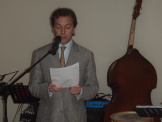 ests to ask their opinions on the past vintages which were available on the tables. They aim to maintain the family feeling of a typical château unlike the banks and insurance giants who have moved into wine in a big way as family concerns buckle under the weight of crippling death duties and inheritance taxes. ests to ask their opinions on the past vintages which were available on the tables. They aim to maintain the family feeling of a typical château unlike the banks and insurance giants who have moved into wine in a big way as family concerns buckle under the weight of crippling death duties and inheritance taxes.
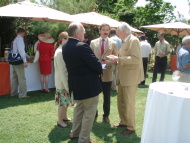 A short excursion for a lunch tasting and buffet the following morning at Château Canon la Gaffelière on the outskirts of the picturesque medieval town of Saint Emilion. Owned by the German count Stephan von Neipperg (www.neipperg.com), an impressive array of samples from top wineries in Germany, Italy, Austria and of course Bordeaux met the eye, including their own. A short excursion for a lunch tasting and buffet the following morning at Château Canon la Gaffelière on the outskirts of the picturesque medieval town of Saint Emilion. Owned by the German count Stephan von Neipperg (www.neipperg.com), an impressive array of samples from top wineries in Germany, Italy, Austria and of course Bordeaux met the eye, including their own.
Further invitations to banquets followed, for example the Cave de Rasteau and the Inter Rhône or from Château Jean Faure for an evening of jazz and barbercue. We also visited the "Sleeping Beauty" castle of Château d'Agassac in the commune of Ludon-Médoc and no less romantic Château Lanessan with neighbouring 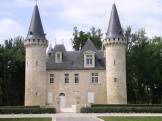 Lachesnaye, which is in the ownership of the Bouteiller family. However, the biggest impression was made by a relative newcomer - Château Sérilhan in Saint-Estephe (www.chateau-serilhan.com). Here we met the proprietor, Didier Marcelis, who explained the situation. The estate was founded by his grandfather Merlet in 1982, and he himself took over the reins in 2003 after 20 years in the high-tech business. He was helped in his new venture by his wife Laurence and Philippe Lespy, doctor of oenology (both previously employed by Domaine Baron Philippe de Rothchild) and external consultants Lachesnaye, which is in the ownership of the Bouteiller family. However, the biggest impression was made by a relative newcomer - Château Sérilhan in Saint-Estephe (www.chateau-serilhan.com). Here we met the proprietor, Didier Marcelis, who explained the situation. The estate was founded by his grandfather Merlet in 1982, and he himself took over the reins in 2003 after 20 years in the high-tech business. He was helped in his new venture by his wife Laurence and Philippe Lespy, doctor of oenology (both previously employed by Domaine Baron Philippe de Rothchild) and external consultants 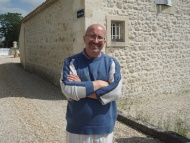 Olivier Dauga a Jean-Luc Thunevin. Much investment has brought the vineyard surface to 22 hectares, new technology has been introduced, new barriques purchased, vineyards have needed replanting. Just two wines are produced here: Château Sérilhan (between 7-8 000 cases annually) and Château Moutinot (3-4000 cases), acting as second wine. Big things are coming to this estate, as attested to by the likes of James Suckling, Robert Parker, Jancis Robinson and Steven Spurrier, who have all been most lavish in their praise of these wines, while the 2004 Sérilhan has garnered awards in such competitions as Vinalies, International Wine Challenge, Concours Mondial de Bruxelles and Japan Wine Challenge. Didier gave us one of the last bottles of 2004 remaining (the 2005 vintage not being bottled at the time of our visit). It was excellent and we only hope that the prices of wine such as this will remain attractive in the future. Olivier Dauga a Jean-Luc Thunevin. Much investment has brought the vineyard surface to 22 hectares, new technology has been introduced, new barriques purchased, vineyards have needed replanting. Just two wines are produced here: Château Sérilhan (between 7-8 000 cases annually) and Château Moutinot (3-4000 cases), acting as second wine. Big things are coming to this estate, as attested to by the likes of James Suckling, Robert Parker, Jancis Robinson and Steven Spurrier, who have all been most lavish in their praise of these wines, while the 2004 Sérilhan has garnered awards in such competitions as Vinalies, International Wine Challenge, Concours Mondial de Bruxelles and Japan Wine Challenge. Didier gave us one of the last bottles of 2004 remaining (the 2005 vintage not being bottled at the time of our visit). It was excellent and we only hope that the prices of wine such as this will remain attractive in the future.
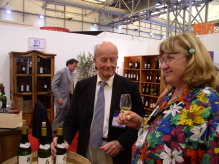 By the end of five days of swirling and spitting everyone was pretty By the end of five days of swirling and spitting everyone was pretty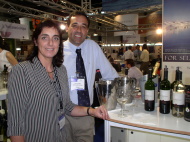 exhausted, although Prince Poniatowski (pictured with me on the left here), the great grand nephew of the last Polish king, was still full of beans and eager to pour his excellent Vouvrays for us going back to vintage 1989! No exhibitors from the Czech Republic this time, but Slovakia, Austria, Hungary and relative newcomers to the serious wine community - Uruguay - all had a substantial presence at the show (pictured here on the right are Ana and Carlos Pizzorno, whom I first met in Uruguay almost a year ago now). exhausted, although Prince Poniatowski (pictured with me on the left here), the great grand nephew of the last Polish king, was still full of beans and eager to pour his excellent Vouvrays for us going back to vintage 1989! No exhibitors from the Czech Republic this time, but Slovakia, Austria, Hungary and relative newcomers to the serious wine community - Uruguay - all had a substantial presence at the show (pictured here on the right are Ana and Carlos Pizzorno, whom I first met in Uruguay almost a year ago now).
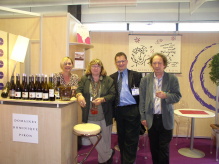 There are problems, though, if Vinexpo wants to maintain its claim as the world's premier wine show, especially in the face of the strides being made by others, such as Düsseldorf and London. Hotel accommodation is one of the main bugbears for visitors, with hotels block-booked several years in advance and prices doubled for those conveniently located on the lake. Infrastructure, too, is a congenital problem. Although the free bus shuttle service has been extended, traffic on the main Bordeaux ring road Rocade remains as intense as ever, leading to long delays for those who come in daily from out-of-town locations. The big plus of Vinexpo Bordeaux remains the close proximity of the world-famous châteaux, some of which extend invitations to lavish parties and gourmet dinners to the lucky visitors. And in this respect, neither ProWein nor LIWS will ever be as attractive and be able to do the same. There are problems, though, if Vinexpo wants to maintain its claim as the world's premier wine show, especially in the face of the strides being made by others, such as Düsseldorf and London. Hotel accommodation is one of the main bugbears for visitors, with hotels block-booked several years in advance and prices doubled for those conveniently located on the lake. Infrastructure, too, is a congenital problem. Although the free bus shuttle service has been extended, traffic on the main Bordeaux ring road Rocade remains as intense as ever, leading to long delays for those who come in daily from out-of-town locations. The big plus of Vinexpo Bordeaux remains the close proximity of the world-famous châteaux, some of which extend invitations to lavish parties and gourmet dinners to the lucky visitors. And in this respect, neither ProWein nor LIWS will ever be as attractive and be able to do the same.
Next Vinexpo is the Asia-Pacific version in Hong Kong, May 2008.
|


